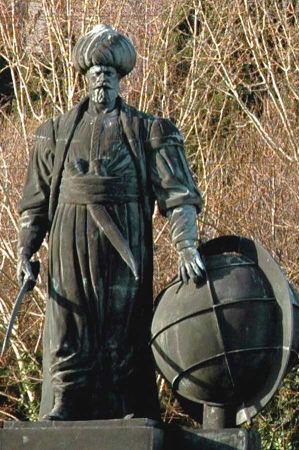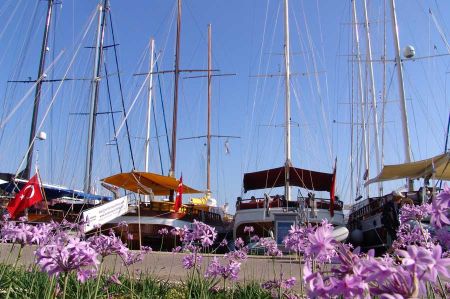Turgutreis - naming follows the legend of Turgut Reis
- Written by Portal Editor
Turgutreis, a small town on the west coast of the Bodrum peninsula, is probably just known for its most famous inhabitant, the pirate and later admiral of the Ottoman fleet, Turgut Reis. The naming of the town is at least based on his person.
Traditionally, mandarins and vegetables were the dominant industry in Turgutreis. In the surrounding area, large fields can be found as agricultural areas for growing figs and grapes, which extend to the city limits. The green areas with oleander, laurel and carob tree continue here. Every Saturday at the weekly market, fresh vegetables and fruit from the surrounding fields and of course the small works of art created by the farmers in the surrounding villages are offered.
Turgutreis has been discovered by tourism for several years. In connection with the question of population density, Turgutreis is one of the most populous places in Turkey. However, the most famous are the spectacular sunsets and the very good wind conditions, which are excellent for windsurfing along the small island off Turgutreis.
The archipelago of the Sporades runs almost parallel to the city and the Greek islands of Kos and Kalymnos are almost within reach. The beach itself is around 2.5 kilometres long and has many bars and restaurants on the bank side, which, according to the latest regulations of the city administration, seem much more organized than before. In the meantime, a yacht club with its own marina has also become established.
From pirate to admiral - Turgut Reis
 From a young age, Turgut Reis served as a gunner's assistant on Turkish galleys and soon became an excellent navigator and gunner. Reis then bought a share in a pirate brigantine, which operated so successfully that he soon became the owner of a galeas and made a name for himself as a daring corsair in the eastern Mediterranean.
From a young age, Turgut Reis served as a gunner's assistant on Turkish galleys and soon became an excellent navigator and gunner. Reis then bought a share in a pirate brigantine, which operated so successfully that he soon became the owner of a galeas and made a name for himself as a daring corsair in the eastern Mediterranean.
From 1538 on, when Turgut Reis joined the privateer fleet under Khair ad-Din Barbarossa (no relationship with Emperor Barbarossa proven), he spread fear and terror in the Mediterranean. Already in the sea battle of Preveza in September 1538, in which a European fleet with 300 ships sent by Emperor Charles V, led by Turgut's lifelong opponent, the Genoese admiral Andrea Doria, was defeated by an Ottoman fleet with 120 ships under Khair ad- Din, within Turgut Reis played a significant role.
At the end of this decade, Turgut was so notorious and feared in the western Mediterranean that the Genoese admiral Andrea Doria was commissioned by Emperor Charles V to eliminate Reis in 1540. Doria subordinated a fleet to his great-nephew Giovanni Andrea Doria, who managed to track down Turgut's squadron of 13 galleys in Corsica, where the corsairs anchored under the walls of a fortress. The fortress began to bombard his ships, hundreds of combative Corsicans gathered on the beach, and at sea Doria blocked the escape route. Turgut decided to surrender and spent the next four years as a Genoese galley slave before he was ransomed by Barbarossa in 1544 for a ransom of 3,000 ducats (and presumably the threat of pillaging Genoa).
After Barbarossa's death (1546), Sultan Suleyman ordered all Ottoman naval forces to recognize Turgut Reis as their admiral. Turgut threatened Naples, sacked the coast of Calabria, and then attacked the Spanish possessions of Susa, Sfax and Monastir on the Tunisian coast in the winter of 1548. In 1549 he conquered the city of Mahdia (al-Mahdiya), at that time the most strongly fortified city on the North African coast, in what is now Tunisia. After long and costly battles for both sides, Andrea Doria and the Bailli and later Grand Master of the Order of Malta, Claude de la Sengle, succeeded in driving Turgut's people out of Mahdia again in September 1550 and taking the city. As the Knights of Malta refused Charles V's offer to administer Mahdia as a fief, the fortress was completely destroyed after a year of Spanish occupation before the withdrawal in 1551.
Turgut escaped with 20 ships to the island of Djerba, which had been his main base since 1524. There Andrea Doria's fleet locked him in a bay. Thereupon Turgut let his people pull the ships overland on a greased boardwalk to the other side of the island and escaped to Constantinople. There, Süleyman appointed him sanjak on the island of Santa Maura, making him an Ottoman official.
Until the end of his life, Turgut Reis played a leading role in the fighting between the Islamic-Turkish and Christian powers in the Mediterranean region. His successes and defeats, his pirate voyages and sieges stretched over large parts of the Mediterranean, from Dalmatia to Tripoli, from the Levant to the Strait of Gibraltar and even as far as the Canary Islands.
Today a bathing and water sports paradise
 Thanks to the prevailing northwest wind (Poyraz), Turgutreis is very suitable for windsurfers and sailors. The offshore archipelago of small, rugged islands and islets such as Çatalada is one of the most beautiful panoramas in the Aegean. The Greek island of Kos is also nearby - it can be reached in an hour with a small transfer ship, but from Bodrum in half an hour with a hydrofoil. Pserimos, Kalymnos and Leros (Dodecanese) can be seen in the evening horizon.
Thanks to the prevailing northwest wind (Poyraz), Turgutreis is very suitable for windsurfers and sailors. The offshore archipelago of small, rugged islands and islets such as Çatalada is one of the most beautiful panoramas in the Aegean. The Greek island of Kos is also nearby - it can be reached in an hour with a small transfer ship, but from Bodrum in half an hour with a hydrofoil. Pserimos, Kalymnos and Leros (Dodecanese) can be seen in the evening horizon.
Gulet day tours cross the archipelago and west to Gümüşlük, the ancient Myndos, which offered Brutus asylum, east to Akyarlar. Turgutreis has a marina and is approximately 45 km from Bodrum-Milas International Airport. There are good connections to numerous major cities in Turkey from the city's bus station. Since 2005 there has been an open-air classical music festival with Turkish and international orchestras and soloists.
Please also read:
Life in Germany - great diversity of cultural influences
Camper Club Staranzano - alternative to camping
